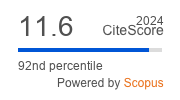RSA ENCRYPTION USING VLSI ARCHITECTURE FOR HIGH SPEED APPLICATIONS
DOI:
https://doi.org/10.29284/ijasis.3.2.2017.21-26Keywords:
Encryption, RSA, modulo 2n 1, Xilinx ISEAbstract
The major concern for the governments and private network communication is the security of systems against eavesdropping and illegal access. To overcome such illegal access the security of modern computer systems uses public-ciphers key namely Rivest, Shamir and Adleman (RSA). The RSA provides both authentication and secrecy of communication. In conventional encryption method the cryptography using RSA provides good secrecy and reduces area but generates more delay due to time taken by the multiplication part. To overcome such a problem, a 32-bit RSA using modulo (2n+1) multiplication based VLSI architecture is presented in this study. This method offers less delay with high performance which can be used in any communication network field. The proposed method is implemented using Xilinx 12.4 ISE and simulated in MODELSIM 6.3c.
References
A.V. Curiger, H. Bonnenberg, and H. Kaeslin, Regular VLSI architectures for multiplication modulo (2/sup n/+ 1), IEEE Journal of Solid-State Circuits, Vol. 26, No.7, 1991, pp.990-994.
E. Chiranth, H.V.A. Chakravarthy, P. Nagamohanareddy, T.H. Umesh, and M. Chethan Kumar, Implementation of RSA Cryptosystem Using Verilog International Journal of Scientific & Engineering Research, Vol. 2, No.5, 2011, pp.1-7.
O. Nibouche, M. Nibouche, A. Bouridane, and A. Belatreche, Fast architectures for FPGA-based implementation of RSA encryption algorithm, International Conference on Field-Programmable Technology, 2004, pp. 271-278.
M. Ciet, M. Neve, E. Peeters, and J.J. Quisquater, Parallel FPGA implementation of RSA with residue number systems-can side-channel threats be avoided?, Symposium on Circuits and Systems Vol. 2, 2003, pp. 806-810.
G.V. Iana, P. Anghelescu, and G. Serban, RSA encryption algorithm implemented on FPGA, International Conference on Applied Electronics 2011, pp. 1-4.
N. Sklavos, P. Kitsos, and O. Koufopavlou, VLSI Design and Implementation of Homophonic Security System, August, IEEE Computer Society Annual Symposium on VLSI, 2012, pp. 69-72.
J.G. Pandey, T. Goel, and A. Karmakar, An efficient VLSI architecture for PRESENT block cipher and its FPGA implementation, International Symposium on VLSI Design and Test Springer, 2017, pp. 270-278.
M. KN and R.K. Karunavathi, Secured High throughput implementation of AES Algorithm, International Journal of Advanced Research in Computer Science and Software Engineering, Vol. 3, No.5, 2013, pp1193-1198.
S. Arrag, A. Hamdoun, and A. Tragha, Design and Implementation A different Architectures of mixcolumn in FPGA, 2012, arXiv preprint arXiv: 1209.3061.
K. Sandyarani and P.N. Kumar, Vlsi Architecture For Nano Wire Based Advanced Encryption Standard (AES) With the Efficient Multiplicative Inverse Unit, International Journal of VLSI design & Communication Systems Vol.8, No.6, 2017,pp-15-22.
R. Rajeswari, Design and Analysis of Various Standard Multipliers Using Low Power Very Large Scale Integration , International Journal of MC Square Scientific Research Vol.4, No.1, 2012, pp-48-57.
R. Zimmermann, Efficient VLSI implementation of modulo (2/sup n//spl plusmn/1) addition and multiplication, IEEE Symposium on Computer Arithmetic, 1999, pp. 158-167.
X. Zhang, and K.K. Parhi, Implementation approaches for the advanced encryption standard algorithm, IEEE Circuits and systems Magazine, Vol. 2, No.4, 2002, pp. 24-46.
S.J. Rayen, P. Bharathi, V. Renuka, and R. Saranya, Revocable-Storage Identity-Based Encryption: Secure Data Sharing In Cloud, International Journal Of Engineering And Computer Science, Vol.6, No.3, 2017, pp. 20558-20563.
Downloads
Published
Issue
Section
License
This work is licensed under a Creative Commons Attribution 4.0 International License, which permits unrestricted use, distribution, and reproduction in any medium, provided the original work is properly cited.











